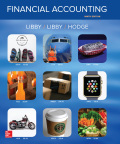
Financial Accounting
9th Edition
ISBN: 9781259738692
Author: Libby
Publisher: MCG
expand_more
expand_more
format_list_bulleted
Concept explainers
Textbook Question
Chapter 3, Problem 3.2ME
Reporting Cash Basis versus Accrual Basis Income
Skidmore Music Company had the following transactions in March:
- a. Sold instruments to customers for $18,000 received $8,000 in cash and the rest on account. The cost of the instruments was $9,000.
- b. Purchased $4,000 of new instruments inventory; paid $1,000 in cash and owed the rest on account.
- c. Paid $900 in wages to employees who worked during the month.
- d. Received $5,000 from customers as deposits on orders of new instruments to be sold to the customers in April.
- e. Received a $300 bill for March utilities that will be paid in April.
Complete the following statements:
| Cash Basis Income Statement | Accrual Basis Income Statement |
| Revenues | Revenues |
| Cash sales | Sales to customers |
| Customer deposits | |
| Expenses | Expenses |
| Inventory purchases | Cost of sales |
| Wages paid | Wages expense |
| Utilities expense | |
| Net income | Net income |
Expert Solution & Answer
Want to see the full answer?
Check out a sample textbook solution
Students have asked these similar questions
I need help with this financial accounting problem using proper accounting guidelines.
I need help with this financial accounting problem using proper accounting guidelines.
Financial Accounting Question please given answer
Chapter 3 Solutions
Financial Accounting
Ch. 3 - Prob. 1QCh. 3 - Prob. 2QCh. 3 - Write the income statement equation and define...Ch. 3 - Explain the difference between a. Revenues and...Ch. 3 - Define accrual accounting and contrast it with...Ch. 3 - Prob. 6QCh. 3 - Explain the expense recognition principle.Ch. 3 - Explain why stockholders equity is increased by...Ch. 3 - Explain why revenues are recorded as credits and...Ch. 3 - Complete the following matrix by entering either...
Ch. 3 - Complete the following matrix by entering either...Ch. 3 - Prob. 12QCh. 3 - State the equation for the net profit margin ratio...Ch. 3 - Which of the following is not a specific account...Ch. 3 - Which of the following is not one of the criteria...Ch. 3 - The expense recognition principle controls a....Ch. 3 - Prob. 4MCQCh. 3 - Prob. 5MCQCh. 3 - Prob. 6MCQCh. 3 - Prob. 7MCQCh. 3 - Prob. 8MCQCh. 3 - Prob. 9MCQCh. 3 - Prob. 10MCQCh. 3 - Prob. 3.1MECh. 3 - Reporting Cash Basis versus Accrual Basis Income...Ch. 3 - Identifying Revenues The following transactions...Ch. 3 - Identifying Expenses The following transactions...Ch. 3 - Prob. 3.5MECh. 3 - Prob. 3.6MECh. 3 - Determining the Financial Statement Effects of...Ch. 3 - Prob. 3.8MECh. 3 - Prob. 3.9MECh. 3 - Identifying the Operating Activities in a...Ch. 3 - Prob. 3.11MECh. 3 - Prob. 3.1ECh. 3 - Reporting Cash Basis versus Accrual Basis Income...Ch. 3 - Identifying Revenues Revenues are normally...Ch. 3 - Identifying Expenses Revenues are normally...Ch. 3 - Prob. 3.5ECh. 3 - Determining Financial Statement Effects of Various...Ch. 3 - Recording Journal Entries Sysco, formed in 1969,...Ch. 3 - Prob. 3.8ECh. 3 - Prob. 3.9ECh. 3 - Analyzing the Effects of Transactions in...Ch. 3 - Preparing an Income Statement Refer to E3-10....Ch. 3 - Prob. 3.12ECh. 3 - Analyzing the Effects of Transactions in...Ch. 3 - Prob. 3.14ECh. 3 - Prob. 3.15ECh. 3 - Prob. 3.16ECh. 3 - Prob. 3.17ECh. 3 - Prob. 3.18ECh. 3 - Prob. 3.19ECh. 3 - Prob. 3.20ECh. 3 - Prob. 3.1PCh. 3 - Recording Journal Entries (AP3-2) Ryan Terlecki...Ch. 3 - Prob. 3.3PCh. 3 - Prob. 3.4PCh. 3 - Prob. 3.5PCh. 3 - Prob. 3.6PCh. 3 - Prob. 3.7PCh. 3 - Recording Nonquantitative Journal Entries (P3-1)...Ch. 3 - Prob. 3.2APCh. 3 - Prob. 3.3APCh. 3 - Prob. 3.4APCh. 3 - Prob. 3.5APCh. 3 - Prob. 3.6APCh. 3 - Accounting for Operating Activities in a New...Ch. 3 - Finding Financial Information Refer to the...Ch. 3 - Finding Financial Information Refer to the...Ch. 3 - Comparing Companies within an Industry Refer to...Ch. 3 - Analyzing a Company over Time Refer to the annual...Ch. 3 - Prob. 3.6CPCh. 3 - Evaluating an Ethical Dilemma Mike Lynch is the...
Knowledge Booster
Learn more about
Need a deep-dive on the concept behind this application? Look no further. Learn more about this topic, accounting and related others by exploring similar questions and additional content below.Similar questions
arrow_back_ios
SEE MORE QUESTIONS
arrow_forward_ios
Recommended textbooks for you
 Managerial Accounting: The Cornerstone of Busines...AccountingISBN:9781337115773Author:Maryanne M. Mowen, Don R. Hansen, Dan L. HeitgerPublisher:Cengage Learning
Managerial Accounting: The Cornerstone of Busines...AccountingISBN:9781337115773Author:Maryanne M. Mowen, Don R. Hansen, Dan L. HeitgerPublisher:Cengage Learning College Accounting, Chapters 1-27 (New in Account...AccountingISBN:9781305666160Author:James A. Heintz, Robert W. ParryPublisher:Cengage Learning
College Accounting, Chapters 1-27 (New in Account...AccountingISBN:9781305666160Author:James A. Heintz, Robert W. ParryPublisher:Cengage Learning

Managerial Accounting: The Cornerstone of Busines...
Accounting
ISBN:9781337115773
Author:Maryanne M. Mowen, Don R. Hansen, Dan L. Heitger
Publisher:Cengage Learning

College Accounting, Chapters 1-27 (New in Account...
Accounting
ISBN:9781305666160
Author:James A. Heintz, Robert W. Parry
Publisher:Cengage Learning
The KEY to Understanding Financial Statements; Author: Accounting Stuff;https://www.youtube.com/watch?v=_F6a0ddbjtI;License: Standard Youtube License